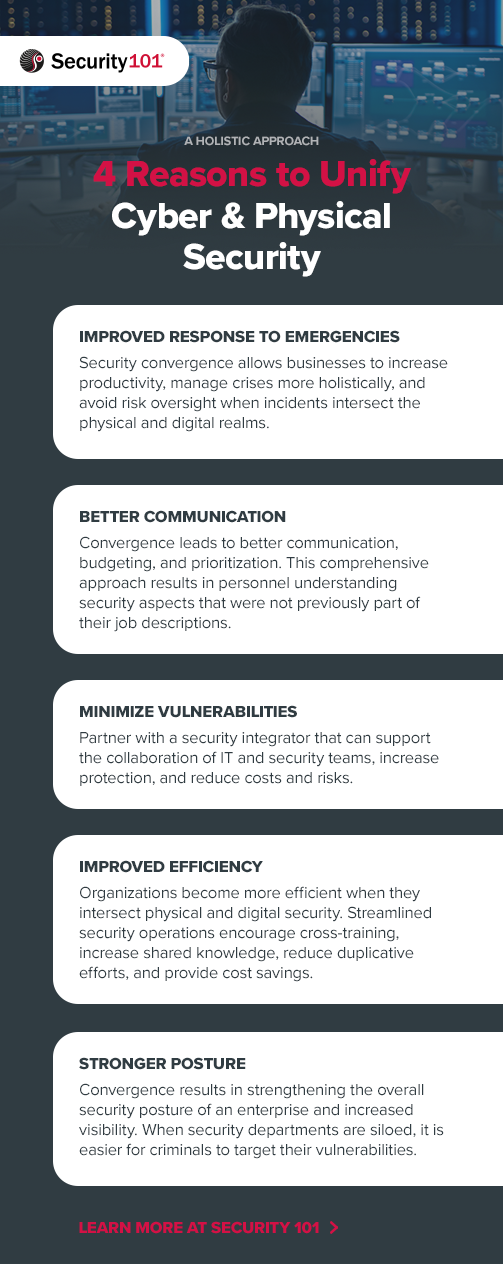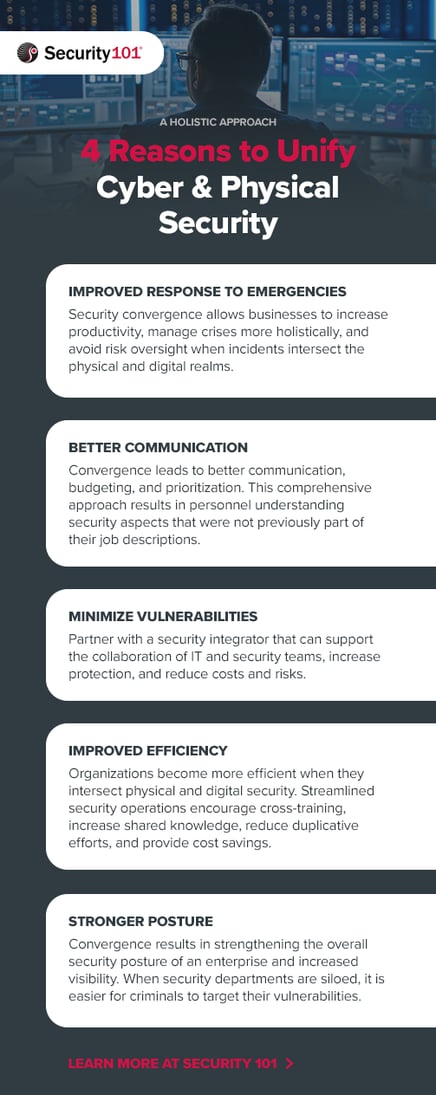Note: This post was updated in February 2024 with new information on the importance of cyber and physical security convergence.
This is a comprehensive guide to the importance of strategically converging logical and physical security operations to better protect your organization.
Find a topic covered in this blog:
The current landscape
A clear lesson was learned after hackers breached the Colonial Pipeline, the largest fuel pipeline in the U.S., in June 2021. With the attack we realized — or confirmed — that cyberattacks have the potential to be devastating and damaging events for any organization, leaving no entity without risk.
In this particular case, a single compromised password led to the entire pipeline being shut down and gasoline shortages across the East Coast. Eventually, the outage gave rise to long lines at gas stations and — not surprisingly — higher fuel prices.
Although the current digital transformation has offered multiple benefits in terms of security advancements, it is also true that it has amplified vulnerabilities by blending cyber and physical threats. Criminals are often ahead of the curve. Not only do they understand the present security vulnerabilities in your industry, but now they are harming enterprises with sophisticated cyber-physical attacks.
Yet, most organizations have not adapted yet to address this lethal, new cyber-physical, holistic view and have kept, unfortunately, security operations fragmented.
There are multiple problems with having physical and cyber security departments working in a kind of bubble, on their own, starting with assisting criminals, unconsciously, by having a feeble approach.
Disruption and segregation
Departmental silos can have a devastating effect on the security, productivity, profitability, and brand reputation of your business.
For instance, now that the Internet of Things (IoT) is more prevalent, with millions of connected devices, organizations might place all their efforts into protecting their data, focusing on virus and malware attacks and avoiding hacker penetration, while neglecting the physical aspect of their security.
This might seem like a strategic move, however, in reality, overlooking more tangible factors and segregating solutions can induce a chain of reactions, including recurrent breaches, elevated risks, and increased costs.
Elements that need to be considered in conjunction with cyber security are:
- Physical access to buildings
- Monitoring capabilities
- Security system maintenance
- Degree of integration
More specifically, communication and operation gaps generate:
- Time delays
- Nonsynchronous data
- Unrelated protection objectives
- Poor/inappropriate response to incidents
- Unnecessary operational costs
- Failure to detect and prevent risks
- Disruption of operations
- Compromise of sensitive data

An effective holistic approach
Simplification and effectiveness are at the core of the reasons to unify the logical and physical security aspects of an organization. The alternative is having the leader of each department come up with different, isolated solutions to a problem, rather than having an aggregate plan that comprehensively mitigates potential risks.
A plan that considers all aspects and players, as well as unintended consequences of a strategy and opportunities to be leveraged by both fronts, without a doubt, makes the entire process much more successful.
Interestingly, The Internet of Things (IoT) has been a massive catalyst for unifying cyber and physical security. The adoption and integration of IoT have created an increasingly interconnected mesh of cyber-physical systems (CPS).
The once clear functions of cybersecurity and physical security are now blurry and convergence is fundamental to avoid a compromise of sensitive or proprietary information, economic damage, or loss of life. For example, IoT-enabled, IP-based cameras or access control devices have presented a new security dilemma for physical security teams, which should be approached in convergence with IT.
The digital revolution and the Internet of Things are urgently calling for a shift in perspective and a combined response to threats from both the Chief Information Security Officer (CISO) and the Chief Security Officer (CSO).
Contrastingly, when there are disjointed security operations, the price to pay can be too high. Hence, organizations must take an all-hazards approach to protection and understand that network security and physical security are presently intertwined disciplines that must be considered as a whole when hardening your facility.
Physical vulnerabilities
Internet of Things devices and solutions often come into contact with people. Cameras, or sensors, for instance, are vulnerable to unauthorized access and tampering.
There are a range of measures that can be utilized to protect your site against most scenarios. Since IoT applications are often remote, physical security is crucial for preventing unauthorized access to a device.
This is where it is valuable to use resilient components and specialized hardware that make your data more difficult to access. Strong remote access control is also necessary. Moreover, strict authentication, authorization, and encryption protocols should be considered.
Benefits of converged security functions
When both physical and cyber security teams collaborate, they gain a comprehensive understanding of the risks the organization must face and mitigate.
They get the whole picture.
A proactive action plan is, therefore, recommended for enterprises to solidify their security strategy through the sharing of information, exchanging resources, restructuring response tactics, and boosting productivity.
These are some additional benefits of security convergence:
Improved response to emergencies
Security convergence allows businesses to increase their productivity, manage crises more holistically, and avoid risk oversight when situations intersect the physical and digital realms.
Better communication
Converged cybersecurity and physical security functions inevitably lead to better communication, budgeting, and prioritization. When a comprehensive approach is taken, personnel can understand security aspects that were not previously part of their job descriptions.
Improved efficiency
Organizations become more efficient when personnel have the skills to intersect physical and digital security. Team coordination and integration of solutions become seamless. Streamlined security operations also encourage cross-training, overall knowledge increase, reduction of duplicative efforts, and cost savings.
Stronger security posture
Technology convergence results in strengthening the overall security posture of an enterprise. When security departments are siloed, there are vulnerabilities that delinquents can easily target.
However, if physical and cybersecurity divisions integrate, organizations can improve visibility into these risks. They will also be better prepared to predict and respond to threats and address them before they escalate.
Criminals are constantly looking for new methods to cause deliberate failures and disruptions, many of which may endanger human lives. As the threat landscape evolves and hybrid attacks become more common, the right efforts to converge cybersecurity and physical security are urgently demanded.
Personalized advice to integrate your security operations
Our team is here to help! Reach out today to learn how we can assist you in strengthening your defense against evolving threats.

